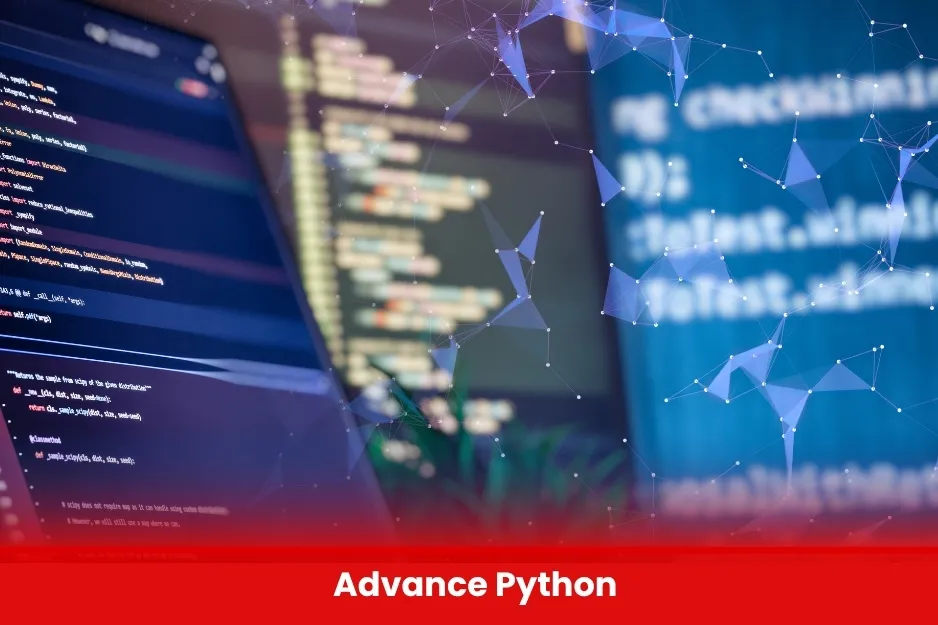Advance Python
Python, known for its versatility and powerful ecosystem, is a critical tool in developing scalable solutions at BURRAQ UK, whether in automation, data analysis, or web applications. This introduction aims to deepen your Python skills with a focus on concepts and practices that match the cutting-edge requirements at BURRAQ UK.

Aim of Advance Python
The aim of learning Advanced Python is to enable developers to write efficient, scalable, and maintainable code by leveraging Python’s deeper features and libraries. This advanced knowledge empowers users to tackle complex problems, optimize performance, and build sophisticated applications across various domains.
Course Overview
Advance Python
Total Modules 6
Training Credits 20
Directed Learning Hours (DLH) 200
Course Code BUK1126
- Basic Python Proficiency
- Participants should have a solid understanding of Python fundamentals including:
- Syntax and basic programming constructs (loops, conditionals, functions)
- Data types (lists, tuples, dictionaries, sets)
- Basic file handling and error handling
- Familiarity with writing simple Python scripts or small projects.
- Participants should have a solid understanding of Python fundamentals including:
- Programming Experience
- At least 6 months to 1 year of programming experience, preferably in Python or a similar language.
- Understanding of basic programming concepts like variables, control flow, and functions.
- Familiarity with Object-Oriented Programming (OOP)
- Knowledge of classes, objects, inheritance, and encapsulation in Python.
- Basic Knowledge of Data Structures and Algorithms
- Understanding common data structures such as arrays, linked lists, stacks, queues, and basic sorting/searching algorithms.
- Comfort with Command-Line Interface (CLI)
- Ability to run Python scripts and manage environments through the terminal or command prompt.
| Course Code | Curriculum Title | Credit | DLH |
|---|---|---|---|
| BUK1126-1 | Introduction | 2 | 20 |
| BUK1126-2 | Install Python | 2 | 20 |
| BUK1126-3 | Install Java and Eclipse | 2 | 20 |
| BUK1126-4 | Install PyCharm | 2 | 20 |
| BUK1126-5 | First Python Program | 2 | 20 |
| BUK1126-6 | Python Indentation | 2 | 20 |
| BUK1126-7 | Numeric Types | 2 | 20 |
| BUK1126-8 | Type Conversion Functions | 2 | 20 |
| BUK1126-9 | Adding and removing list elements | 2 | 20 |
| BUK1126-10 | Input and Output Functions | 2 | 20 |
Objectives
- Introduction
- Install Python
- Which IDE?
- Install Java and Eclipse
- Install PyDev for eclipse
- PyDev Tips
- Install PyCharm
- Download the completed projects and Assignments
- First Python Program
- Comments
- Python Indentation
- Introduction
- Numeric Types
- Complex , Binary and Hexadecimal Types
- Boolean Types
- Type Conversion Functions
- Identifiers
- Datatypes
- Datatypes
- Introduction
- Create a string
- Slicing a string
- Steps in slicing
- Strip the spaces
- Few more string methods
- Data Types
- Create a list
- Adding and removing list elements
- Few more list functions
- Tuple
- Use a Tuple
- List to Tuple
- List vs Tuple
- Set Type
- Frozen Set
- range type
- bytes and byte array
- Dictionary
- Immutability
- Datatypes Patient Use case
- Map of Lists Use case
- Sequence Types
- Collection Types
- None type
- Escape chars
- Constants
- del keyword
- Data Types Summary
- Special Types
- Arithmetic Operators
- Assignment Operators
- Comparison Operators
- Operators BMI Usecase
- Operators and Operands
- Introduction
- print and string formatting
- input
- reading multiple inputs
- Input and Output functions
- Input and Output Functions
- Read and Display student details
- Average of three numbers
- Area of a circle
- Using the math module
- Introduction
- If Else Syntax
- Find even or odd number
- IF Else Ladder
- Handle Zero
- If-Else Ladder
- While Syntax
- Display numbers from 1 to 20
- Odd numbers between given numbers
- For Syntax
- using for loop
- product of numbers in a list
- multiplication table of a given number
- break
- continue
- assert
- More Programs – Remove Duplicates in List
- More Programs – Count Vowels in a word
- More Programs – Handle employee Details
- Flow Control Statements
- Loops
- Input and Output functions
- Reverse a String
- Reverse using split and join
- Reverse the words in a string
- Reverse the characters in the words
- Remove Duplicate Chars
- Count the characters
- Print Right Angled Triangle
- Print Pyramid Pattern
- Find substrings in a given string
- Introduction
- command line arguments
- command line arguments in PyCharm
- Command Line Arguments
- Command line arguments
- Introduction
- first function
- returning a result
- return multiple values
- local and global variables
- accessing global variable with the same name
- assign function to a variable
- function inside another
- function as parameter to an other
- returning functions
- pass any type
- Recursion
- recursion
- keyword arguments
- default arguments
- BMI Usecase
- *args and **kwargs
- passing optionals params to other functions
- Functions
- Introduction
- Lambda – Cube of a given number
- Lambda – Even or Odd
- Lambda – Sum of two numbers
- Using a filter
- Using the map function
- Using reduce function
- Decorators
- Decorator that doubles the result of a function
- Using @ Decorator
- Decorating Strings
- Decorator Chaining
- Generators
- Create a generator
- Keywords in python
- Lambdas and More
- Introduction
- Create a module and use it
- Different ways to import
- Use Math Module
- Use Random Module
- Modules
- List Comprehensions
- Cube of numbers in a list
- Even numbers in a list
- Product of numbers in a list
- Common elements in a list
- Introduction
- The 4 OOP principles
- Classes and Objects
- Create first class
- Use Parameterized Constructor
- Define a instance method
- Create Getter and Setter methods
- Define instance methods
- Methods vs Constructors
- Define static field
- Count the number of Objects
- Create a Inner Class
- Garbage Collection
- GC Methods
- Use Destructor
- Patient Clinicals Use case
- Classes and Objects
- Introduction
- Private Fields and Name Mangling
- Implementing Encapsulation
- Encapsulation
- Encapsulation
- Inheritance
- Inheritance in action
- Inheriting Functionality
- Overriding
- Using Super()
- Inheritance
- Introduction
- DuckTyping
- DuckTyping for Dependency Injection
- Operator Overloading
- Runtime Polymorphism
- Abstract Classes and Interfaces
- Create an Abstract Class
- Create an Interface
- Abstraction
- Abstraction
- Introduction
- Exception Class Hierarchy
- Handling Exceptions
- Using Finally
- Else
- Create and Raise Custom Exceptions
- More Programs – Custom Exceptions
- Logging in action
- Logging Configuration
- Log Exceptions
- Using Assertions
- Exception Handling Assertions and Logging
- Exception Handling
- Introduction
- Write string to a file
- Read from a file
- Write multiple strings
- Check if the file exists
- Pickle
- UnPickle
- Introduction
- Sequence Characters
- search()
- findall() and match()
- split()
- substitute()
- Quantifiers
- using quantifiers
- Matching dates
- Special Characters
- using special characters
- Regular Expressions
- Date and Time
- Time since epoch
- Finding the current date and time
- Combining Date and Time
- Sorting dates
- sleep()
- Knowing the execution time of a program
- Validate Credit Card Usecase
- Project Management Usecase
- Date and Time
- Date Time and Classes
- Introduction
- Main Thread
- Thread using a function
- Printing Thread Names
- Thread extending the Thread Class
- Thread using a class
- Multithreading in action
- using sleep()
- The Ticket Booking use case
- Thread Synchronization
- Add more logic
- Synchronization using lock
- Synchronization using semaphore
- Thread Communication
- Using a boolean flag
- Run and summarize
- Thread Communication using wait and notify
- Use wait and notify
- Queues and Thread Communication
- Producer Consumer Pattern
- Three Types of queues
- Types of queues
- Introduction
- Downloading a HTML
- Downloading a Image
- Socket Programming
- Create a server
- Create a client
- File Server
- File Client
- Sending Emails
- Email Client
- Run Mail Client
- Introduction
- Install MySQL
- Install MySQL workbench
- Install MySQL connector
- Setup the database
- Connect to the DB from Python
- READ
- READ – fetch all
- CREATE
- DELETE
- Introduction
- Setup the database
- Install psycopg2
- Connect and Insert
- Fetch Data
- Mongo Introduction
- Install Mongo
- Use Mongo Console
- Install pimento
- API walkthrough
- insert one
- insert many
- read
- update
- delete
- Use case
- Debugging in PyDev
- Debugging in PyCharm
- Using Virtual Environment
- Introduction
- Create and run a test
- Assert for exceptions
- setup and teardown
- Assignment
- Documentation
- Software Developers and Programmer
- Automation Engineers
- Data Analysts & Data Scientists
- Web Developers
- Students & Graduates in Computer Science / IT
- Professionals in Technical Roles at BURRAQ UK
- Freelancers and Tech Enthusiasts
- All Modules within this qualification are assessed internally by the approved training Centre and externally verified by BURRAQ UK. The program uses a criterion-referenced assessment approach to ensure that learners successfully meet all required learning outcomes.
- A Pass in any unit is granted only when the learner submits valid, reliable, and authentic evidence that demonstrates achievement of the assessment criteria. The Assessor is responsible for reviewing this evidence and confirming that the learner has attained the expected standa
